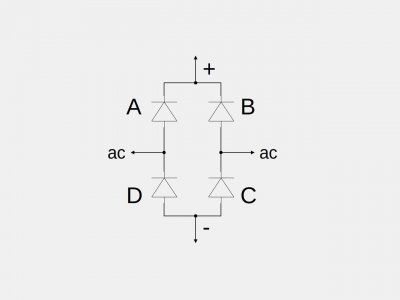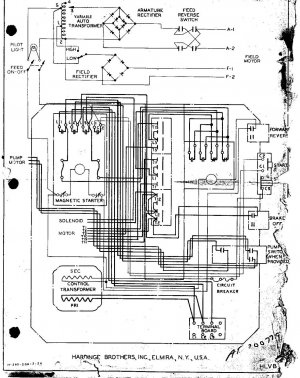- Joined
- Sep 1, 2023
- Messages
- 68
I recently acquired an HLV with a power feed motor that won't run, and took the time today to diagnose things, and evaluate possible fixes.
From my understanding, the power feed motor is a DC brushed motor, and the DC current produced by the rheostat based controller.
I have disassembled the powerfeed motor, tested the resistance of the two (stator and rotor) coils, and I think I have found the problem: the resistance of the stator coil is way to high.
The measured value is 412 Ohm, so some current can go through it, but most likely not enough to get the motor to move.
I'd first like to confirm that the problem is indeed with the stator coil, my knowledge of electronics is minimal, perhaps there is nothing wrong with 412 Ohm resistance from the stator coil.
I figured it was to high, simply because it is high in comparison to the 31.6 Ohms that I measured from the rotor coil.
I also measured current coming out of the controller (disconnected from the motor) as I rotated the dial, and flipped the high/low switch, and I could make sense of the data collected, and it looked like a functionning controller:
1. flipping the high,low switch made the voltage going to the stator vary from 83v to 198v
2. turning the dial, made the voltage going to the rotor vary from 25v to 179v
So my tests seem to indicate that the controller is working, and the motor broken, apparently as a result of a burned out stator coil.
If the problem is with the stator coil, it seems easy enough to replace, there are only two windings (or poles ?), but I need to make sure I have the right diagnosis.
From my understanding, the power feed motor is a DC brushed motor, and the DC current produced by the rheostat based controller.
I have disassembled the powerfeed motor, tested the resistance of the two (stator and rotor) coils, and I think I have found the problem: the resistance of the stator coil is way to high.
The measured value is 412 Ohm, so some current can go through it, but most likely not enough to get the motor to move.
I'd first like to confirm that the problem is indeed with the stator coil, my knowledge of electronics is minimal, perhaps there is nothing wrong with 412 Ohm resistance from the stator coil.
I figured it was to high, simply because it is high in comparison to the 31.6 Ohms that I measured from the rotor coil.
I also measured current coming out of the controller (disconnected from the motor) as I rotated the dial, and flipped the high/low switch, and I could make sense of the data collected, and it looked like a functionning controller:
1. flipping the high,low switch made the voltage going to the stator vary from 83v to 198v
2. turning the dial, made the voltage going to the rotor vary from 25v to 179v
So my tests seem to indicate that the controller is working, and the motor broken, apparently as a result of a burned out stator coil.
If the problem is with the stator coil, it seems easy enough to replace, there are only two windings (or poles ?), but I need to make sure I have the right diagnosis.



